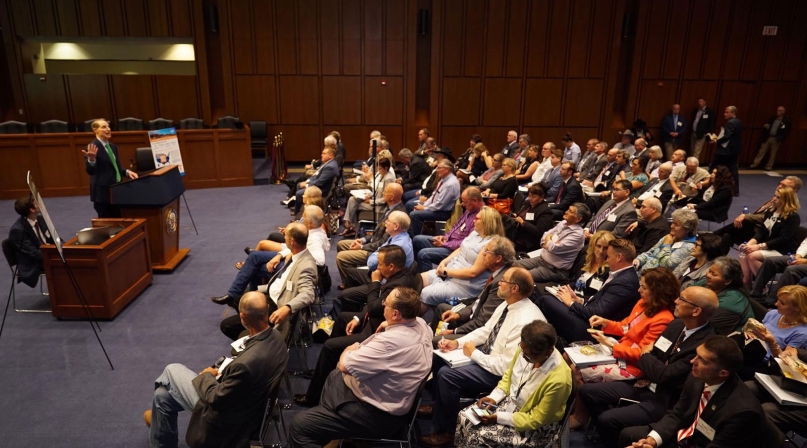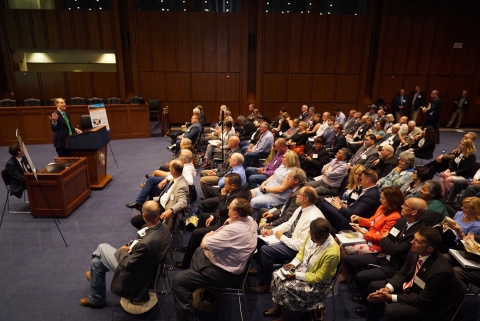Robust crowd turns out to advocate for PILT, SRS

Key Takeaways
One of the largest PILT fly-ins in years brought roughly 100 county officials to Capitol Hill Sept. 11 to advocate on behalf of permanent mandatory funding for the Payment in Lieu of Taxes (PILT) program and permanent funding for the Secure Rural Schools (SRS) program.
Both programs compensate counties that contain federally managed land, which cannot yield property tax revenue and counties that have seen a decline in timber harvests from federally managed forest land. PILT paid out $514 million in fiscal year 2019.
County officials met with members of Congress and their staffs, primarily from their home states and members that serve on appropriations committees and authorizing committees that could help advance legislation.
During a Capitol Hill briefing, Sen. Ron Wyden (D-Ore.) discussed his proposal to reauthoritze PILT for 10 years.
Sen. Steve Daines (R-Mont.) talked up his bill that would expand PILT funding for counties with fewer than 5,000 residents. It would not reduce the PILT amounts paid to larger counties.
One of the most effective points a county official can make is showing how federal policy affects local management and services. For Chaves County, N.M. Commissioner Robert Corn, volatility is a huge problem.
“We don’t know if it (PILT funding) is coming, when it’s coming, how much is coming,” he said. “We fund vehicles for the roads department and sheriff’s office with PILT money, so if it’s not looking good, it’s a matter of trying to get a few more thousand miles out of a vehicle and hoping it holds, rather than replacing it.”
Supervisor Richard Lunt demonstrated to his congressional delegation how budgeting in Greenlee County, Ariz. was complicated by irregular PILT funding.
“We can’t get the biggest bang for our buck, being able to do purchasing that is efficient, buying in bulk, if we don’t have the money,” he said. “The government knows it’s getting a bargain for the services we provide around federal lands. Every year hunters get lost, and every year, we’re sending out law enforcement to find them. It’s something we’re glad to do but there’s no question it’s a bargain for what the federal government gets.”
The large fly-in contingent coincided with an influx of freshman members of Congress. Cascade County, Mont. Commissioner Joe Briggs, who serves as NACo’s West Region representative, offered some advice to newcomers to Capitol Hill.
“There can be an assumption that all the congressional staff members know what the other staffs are doing, and that’s not the case,” he said. “Sometimes we are a bridge, telling them what else we have heard on the Hill because they can get siloed in their offices.”

Attachments
Related News

U.S. House of Representatives passes SPEED Act and other permitting reform bills
On December 18, the U.S. House of Representatives passed the SPEED Act (H.R. 4776). The SPEED Act would strengthen county involvement in decision-making and make needed commonsense reforms to the federal environmental review process.

House Natural Resources Committee advances the Endangered Species Act Amendments Act of 2025
On December 17, the House Natural Resources Committee advanced the Endangered Species Act (ESA) Amendments Act of 2025 (H.R. 1897). The version passed by the committee adopted several changes from the initial bill and would address key county concerns by improving the implementation of the ESA. The legislation now awaits a floor vote before the whole U.S. House of Representatives.

County Countdown – Dec. 15, 2025
Every other week, NACo's County Countdown reviews top federal policy advocacy items with an eye towards counties and the intergovernmental partnership.
